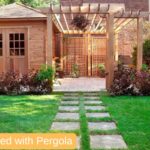A garden with a swing can transform your outdoor space into a relaxing retreat where you can unwind, enjoy nature, and spend quality time with family and friends. Adding a swing to your garden not only enhances the aesthetic appeal of your landscape but also provides functional benefits, making your garden a welcoming and serene haven. In this article, Garden 03 will explore various types of garden swings, their benefits, tips on choosing the right one, and how to integrate it into your garden design.
Why Add a Swing to Your Garden?

1. Aesthetic Appeal
A garden with a swing is visually inviting, adding charm and a touch of whimsy to any outdoor space. Swings can be designed to match the style of your garden, whether it’s rustic, modern, or traditional. Wooden swings evoke a classic, nostalgic feel, while metal or wicker swings can offer a more contemporary look.
2. A Place to Relax
A swing offers a peaceful spot to relax and enjoy your garden. The gentle motion of the swing can be soothing, making it a perfect place to sit and enjoy a book, sip your morning coffee, or simply enjoy the sounds of nature. A garden with a swing is an ideal space for mindfulness and relaxation.
3. Encourages Outdoor Activity
A swing encourages you and your family to spend more time outdoors. Children love the playful element of a swing, while adults can enjoy the therapeutic motion. Having a designated seating area with a swing can also make outdoor gatherings more enjoyable.
4. Enhances Property Value
Investing in a swing and incorporating it into your garden design can enhance the overall appeal of your home. A well-maintained garden with thoughtful features such as a swing can increase the curb appeal and value of your property.
Choosing the Right Swing for Your Garden
1. Swing Materials
When selecting a swing, the material plays an important role in both appearance and durability. Here are a few popular materials for garden swings:
- Wooden Swings: Wooden swings are a classic choice for gardens, offering a natural and rustic look. They are typically made from hardwoods like teak, cedar, or oak, which are resistant to rot and insects. Wooden swings require regular maintenance, such as staining or sealing, to protect them from weather damage.
- Metal Swings: Metal swings are durable and can add a modern or industrial feel to your garden. They are often powder-coated to resist rust, making them a good option for areas with high humidity or frequent rain.
- Wicker Swings: Wicker swings provide a cozy and charming feel, perfect for gardens with a cottage or bohemian aesthetic. Synthetic wicker is more durable and weather-resistant than natural wicker, making it a practical choice for outdoor use.
- Plastic Swings: Plastic swings are lightweight, affordable, and available in a variety of colors and designs. While not as durable as other materials, they are low-maintenance and can be easily cleaned.
2. Swing Types
There are various types of swings to choose from, depending on your garden’s layout and your personal preferences:
- Traditional Garden Bench Swing: A bench swing is one of the most popular types. It typically seats two or more people and can be freestanding or attached to a frame or pergola. These swings offer comfort and stability, making them ideal for family use.
- Hammock Swing: A hammock swing combines the comfort of a hammock with the fun of a swing. They are usually made of fabric or rope and can be hung from a sturdy tree or a stand. A hammock swing is perfect for lounging and napping in a shady spot in your garden.
- Canopy Swing: A canopy swing is similar to a bench swing but comes with a built-in canopy to provide shade. This type of swing is perfect for sunny gardens where you want to relax without being exposed to direct sunlight.
- Porch Swing: If you have a patio or porch overlooking your garden, a porch swing can create a seamless transition between your indoor and outdoor spaces. Porch swings are often suspended from the ceiling and offer a cozy place to enjoy your garden views.
- Tree Swing: For a playful and nostalgic feel, a simple tree swing hung from a sturdy branch can add a whimsical element to your garden. Tree swings are great for children and can be a fun addition to any garden design.
3. Consider the Size and Placement
When selecting a swing for your garden, consider the available space. A large, freestanding swing may dominate a small garden, while a smaller, hanging swing may get lost in a large space. Measure the area where you plan to place the swing and ensure there is enough room for the swing to move freely without hitting nearby plants, trees, or structures.
Placement is also key for maximizing comfort and enjoyment. Choose a spot with partial shade to keep cool while swinging. If you have a beautiful garden view, position the swing to face it for a more immersive experience. For families, placing the swing near a play area or garden path can make it more accessible and enjoyable for children.
Integrating the Swing into Your Garden Design
1. Create a Focal Point
A swing can serve as the focal point of your garden, drawing attention and creating a cozy centerpiece. Frame the swing with plants, flowers, or a pergola to make it stand out while blending harmoniously with the rest of the landscape. You can also add a path leading to the swing, guiding visitors through the garden and inviting them to sit and relax.
2. Surround with Plants
Plants can enhance the ambiance of your garden with a swing by adding color, texture, and fragrance. Choose plants that complement the style of your swing. For example, climbing vines like jasmine or wisteria can be trained to grow around a pergola or arbor over a swing, creating a romantic and fragrant setting.
Consider adding a mix of tall plants for privacy and low-growing plants or flowers around the base of the swing. This will create a lush, inviting space while maintaining visibility and openness. Plants like lavender, ferns, and ornamental grasses are excellent choices for creating a serene atmosphere.
3. Lighting and Accessories
Lighting can extend the use of your garden with a swing into the evening hours, creating a magical atmosphere. String lights, lanterns, or solar-powered garden lights can be hung around the swing or along nearby trees to provide soft, ambient lighting. This is especially useful if you enjoy spending time in your garden at night.
Accessorizing the swing with cushions, blankets, and throw pillows adds comfort and style. Choose outdoor fabrics that are weather-resistant and easy to clean. Opt for patterns and colors that complement your garden’s color palette for a cohesive look.
4. Creating a Multi-Functional Space
A garden with a swing can be more than just a seating area. By incorporating elements like a fire pit, water feature, or outdoor dining set nearby, you can create a multi-functional space for relaxation, entertainment, and socializing.
For example, a swing placed near a small pond or fountain can provide a peaceful spot to enjoy the soothing sounds of water. Alternatively, adding a swing near your outdoor kitchen or barbecue area creates a cozy seating area where guests can relax while you cook.
Safety Considerations for Your Garden Swing
While a garden swing adds beauty and fun to your outdoor space, safety should always be a top priority. Here are some important safety tips to keep in mind:
- Ensure Proper Installation: Whether you’re installing a freestanding swing or a hanging swing, make sure it is securely anchored and balanced. Follow the manufacturer’s instructions carefully or hire a professional to ensure the swing is safe to use.
- Weight Limit: Be mindful of the swing’s weight capacity and avoid exceeding it. Check for signs of wear and tear regularly, especially on the ropes, chains, or hardware.
- Keep the Area Clear: Ensure the swing has enough clearance to move freely without hitting any obstacles. Avoid placing the swing near sharp objects or hard surfaces that could cause injury if someone falls.
- Supervise Children: If you have children using the swing, always supervise them to prevent accidents. Teach them proper safety rules, such as sitting properly on the swing and not jumping off while it is moving.
Maintenance Tips for a Long-Lasting Swing
To keep your garden swing looking beautiful and functioning properly, regular maintenance is essential. Here are some tips to help you care for your swing:
- Clean Regularly: Depending on the material, your swing may require different cleaning methods. Wooden swings should be wiped down regularly to remove dirt and debris, and periodically treated with a sealant or oil. Metal swings should be checked for rust and cleaned with a mild detergent. For fabric or wicker swings, spot-clean any stains and remove cushions when not in use to prevent fading or mildew.
- Inspect for Wear: Check the swing’s chains, ropes, and fasteners regularly to ensure they are in good condition. Replace any worn or damaged parts promptly to prevent accidents.
- Protect from the Elements: If possible, cover your swing during the winter months or periods of heavy rain to protect it from weather damage. You can also move a lightweight swing indoors or into a garage or shed for storage during harsh weather conditions.
Conclusion
A garden with a swing offers an idyllic, relaxing spot where you can enjoy the beauty of nature and the outdoors. Whether you choose a classic wooden bench swing, a hammock swing, or a playful tree swing, incorporating this element into your garden design can enhance both the functionality and visual appeal of your outdoor space. By selecting the right materials, considering placement, and adding personal touches like plants and lighting, you can create a serene oasis that will be enjoyed for years to come.





